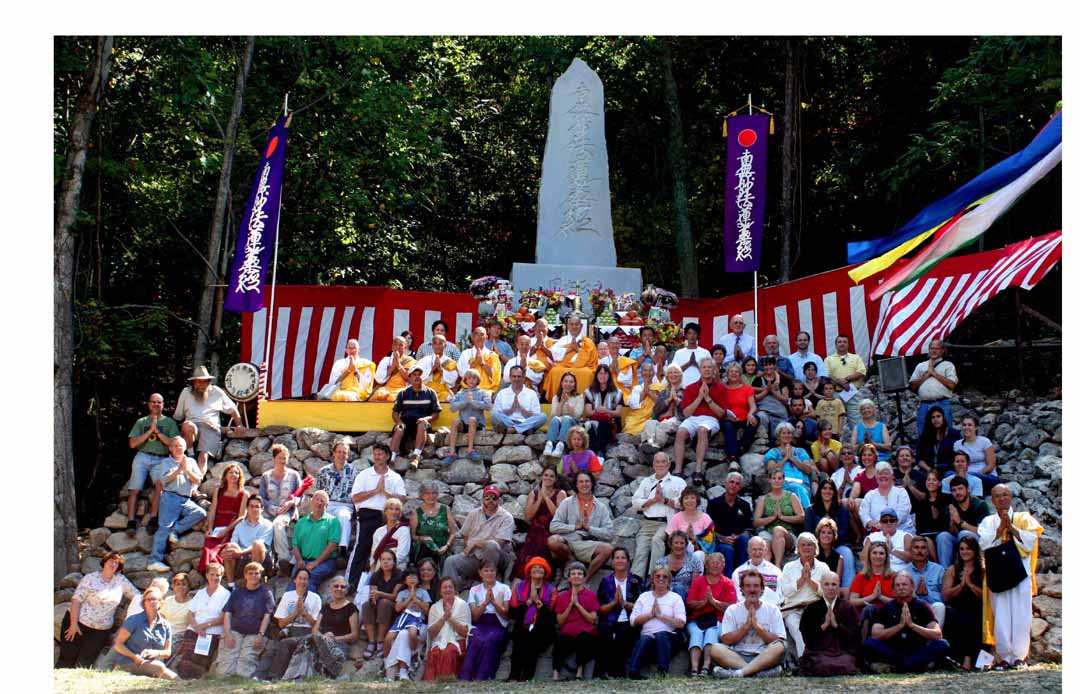|
|
 |

|
| At the conclusion of the 2007 Dedication Ceremony |
 |
 |
|
Gendai Hoto [Stone Pagoda]
|
|
--Carved into the front face of the Stone Pagoda is the peace mantra NA MU MYO HO REN GE KYO, read from top to bottom, in
the traditional style of calligraphy, which makes a vertical sequence to symbolically connect heaven and earth.
--Underneath, read from right to left, are the words RISSHO ANKOKU, which means Giving Rise to the True Dharma for Peace
and Tranquility of the Land and is the title of a treatise written by Nichiren Daishonin, a 13th century Japanese Buddhist
prophet,.
--On the back side, from top to bottom, starting on the right column and reading left: ITTEN SHIKAI, KAIKI MYOHO. MAPPO
MANNEN, KOSEN RUFU. Translation: One heaven, four seas embrace the Ineffable Dharma. Proclaim and spread it far and wide
in the 10,000 years of the Era of Final Dharma. The heavens and seas represent the entire world; the Ineffable Dharma is Na
Mu Myo Ho Ren Ge Kyo; and "proclaim and spread it far and wide," means to aspire for a world united in peace by
chanting Na Mu Myo Ho Ren Ge Kyo.
--Horizontally on the back, from right to left is KOKUYO-SHARI, which means Make offerings to my [Lord Buddha's] relics,
far and wide.
All calligraphy carved into the stone was originally done by the Most Venerable Nichidatsu Fujii, Founder of Nipponzan
Myohoji.
|
|
 |
 |
|
 |
|
 |
 |
|
Explanation of the Gendai Hoto
|
|
Stone pagodas are not known to the people in America, but Japan has a tradition of inscribing the sacred presence of gods,
deities and Buddhas on stone. The Gendai-hoto, the stone pagoda, inscribes the Odaimoku, Na Mu Myo Ho Ren Ge Kyo. Nichiren
Daishonin, who started to chant Na Mu Myo Ho Ren Ge Kyo more than 750 years ago, wrote in a letter to a lay follower saying:
You have erected a stupa, 1 jo and 8 shaku (4.84 m) inscribing the seven characters of Na Mu Myo Ho Ren Ge Kyo. It is said
that when the north wind blows past [this stupa], fish in the southern sea touched by this wind will be freed from their sufferings
in the vast sea; when wind passes over it from the east, birds and deer in the western mountains who are touched by it will
escape from the realm of animals and be born in the inner court of the Tushita heaven. How much greater will be the blessings
on those human beings who rejoice at this stupa, touch it with their hands, or gaze upon it with their eyes!
|
|
 |
 |
|
 |
|
|
 |
|
|
 |
|
|
|
|
Enter supporting content here
|
|
|
 |

